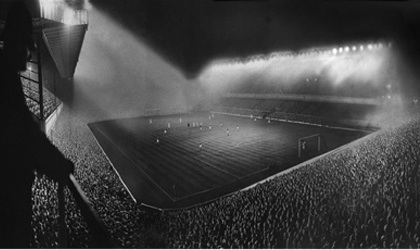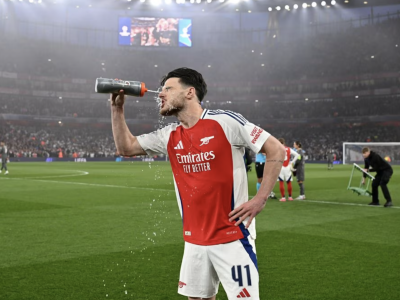Arsenal’s first floodlit game had actually occurred as early as 16th March 1896, during their days as Woolwich Arsenal. The fixture was an away friendly fixture with Thames Ironworks F.C. (a predecessor club to West Ham United) and had ended 5-3 in Arsenal’s favour. For the occasion, the Irons’ pitch at Canning Town had been surrounded by light bulbs which had the equivalent power to two thousand candles. They were attached to ten pitch side poles, with the ball dipped in pails of whitewash to make it more visible.
By the inter-war period, both Speedway and Greyhound Racing became hugely successful midweek floodlit spectator sports and when Arsenal opened their new West Stand at Highbury in 1932, Herbert Chapman arranged for floodlights to be built in after a fact finding trip to France and Belgium, where the floodlit game was already officially sanctioned. The Football Association and Football League however banned their use in December 1930, even reprimanding Watford for switching on their trackside lighting (used for Greyhound Racing) during a match. It wasn’t until after the Second World War that attitudes toward floodlit games began to change and was partly due to poor attendances for mid-week afternoon fixtures and the backlog of games from the severe winter of 1946/47 which actually stretched the season out until mid-June.
In 1949, Arsenal undertook a tour of Brazil and, as described by former Arsenal player Bernard Joy in his famed piece ‘Forward Arsenal’: ‘the effectiveness and popularity of floodlighting impressed the Arsenal party most and encouraged them to speed up the installation at Highbury’. Arsenal manager Tom Whittaker, who briefly managed the England side for an end of season tour of the continent in 1946, was in attendance during England’s 1950 World Cup Finals campaign in Brazil and noted in his autobiography that he had been ‘pleasantly surprised’ at the reaction of leading F.A. officials toward the Brazilian use of floodlights for training purposes. The F.A. revoked their ban in December 1950, however only with regard to non-competitive fixtures. Arsenal were again to be early pioneers in becoming the first top flight club to arrange mid-week floodlit friendlies, the very first being a 5-1 defeat of Israeli side Hapoel Tel Aviv on 19th September 1951, followed by the annual fixture with Rangers a month later which Arsenal won 3-2.
The following year, the first ever televised floodlit match also took place at Highbury against Hibernian, described in the Radio Times as ‘a charity match at the Arsenal Stadium, Highbury, in aid of the National Playing Fields Association and of the Central Council of Physical Recreation’, whose president – the Duke of Edinburgh – was in attendance. As seen here, the match was covered live from the second half onwards by BBC Television, with Arsenal running out 7-1 winners on the night aided by five goals from Don Roper. In his autobiography, published in 1956, Tom Whittaker remarked that: ‘it seems that television is almost inseparable from floodlit games these days’, though the main beneficiary was to be Wolves rather than Arsenal, who as Champions of England featured in a televised game against Hungarian champions Honved in December 1954.
Wolves won 3-2 against a side which included Ferenc Puskas, Sandor Kocsis and another four of the ‘Magnificent Magyars’ who humiliated England at Wembley 6-3 a year earlier, which to many English observers felt like payback. There followed further high profile friendly victories for Wolves against Dynamo Moscow and Real Madrid among others over the next four years. Such was the success of the midweek floodlit game that, with the creation of ITV in 1955, plans were afoot for a ten-team breakaway Anglo-Scottish Floodlit TV League of which Arsenal were party to. Unlike the Premiership, it was intended to run alongside the Football League rather than as a replacement, however the English and Scottish Leagues threatened the ten sides with expulsion if their plan proceeded.
The competition unofficially went ahead as the Anglo-Scottish Midweek Cup, but didn’t involve Arsenal. The Gunners however were party to the Southern Floodlit Challenge Cup, a competition which they won in 1959, beating Crystal Palace 2-1 in the Final. Both competitions though would be discontinued with the introduction of the Football League Cup and the creation of UEFA’s triumvirate of European Club competitions – the European Cup, Cup Winners Cup and Inter-City Fairs Cup. For the first half of the sixties however, Arsenal were rarely in either the League Cup or European competition and mid-week floodlit fixtures usually included the continuance of the annual match with Racing Club Paris (the 1958 fixture won with an audacious back heel by Jackie Henderson (@0.36)), as well as friendlies against Euro Super clubs such as Juventus and Real Madrid and even a Brazil XI in 1965
By the early 1970s, both European club competition and the League Cup were now well established and friendly fixtures were largely uncompetitive affairs attached to the start or end of a season. The introduction of sponsorship to Football had brought new weird and wonderful competitions such as the Texaco Cup and the Watney Cup, though Arsenal were never involved in either of the aforementioned. They did however appear in one pre-season oddity from the period in the shape of the FA Cup 3rd/4th place play off of 1973. Arsenal were beaten by Wolves, however the fixture was akin to a football equivalent of the world’s tallest midget competition, as seen from the empty seats around Highbury as only 20,000 bothered to attend. In a Sunday Times report on the match, Brian Glanville had stated that: ‘Wolves, for what it's worth, take third place in last year's FA Cup. If that sentence makes little sense to you, it is nonetheless factually impeccable’. Arsenal even had a hand in creating the fixture, which actually had its roots two decades earlier from their title winning game against Burnley in 1953.
That match took place on the Friday evening before the famous ‘Matthews Cup Final’ and the club had observed that many who were in attendance were Blackpool and Bolton fans in London on the eve of the FA Cup Final, who wanted to take in a match. Sensing an opportunity, the following year Arsenal arranged a fixture between an England XI (mainly made up of over 30s) and a ‘Young’ England side made up of under 23s, with 54,000 in attendance. Among the participants had been Stanley Matthews, Wilf Mannion, Tommy Lawton and Len Shackleton for the over 30s and playing for Young England had been three of the Busby Babes – Dennis Violett, as well as Duncan Edwards and Roger Byrne who passed away in the Munich air crash four years later.
The fixture continued until 1970 when dwindling attendances meant that it was revamped as an FA Cup 3rd/4th place play off fixture, the first involved Watford and Manchester United at Highbury, with 15,000 in attendance. By 1972, the fixture was moved to the start of the following season as opposed to the eve of the FA Cup Final, however after Arsenal’s defeat to Wolves in 1973 the fixture limped on for one more year with the final play off in 1974 between Burnley and Leicester at Filbert Street attracting just 6,458 in attendance.
Through the seventies and early eighties, pre and post-season friendlies began to be seen as a way of building on Arsenal’s reputation overseas, such as this 2-0 defeat to a Malaysia XI side in May 1975 and a 1-1 draw with the Saudi Arabian national side ten years later. During mid-season there was also the Evening Standard Five-a-side tournament, such as this Semi Final footage from 1983 with Gary Lewin in goal for Arsenal and a young Teddy Sheringham playing for Millwall. However, as will be covered next week in Part three (next Thursday), it took another absence of English involvement in European football for such friendly competitions to again increase in importance in the scheme of things.
*Follow me on Twitter@robert_exley







